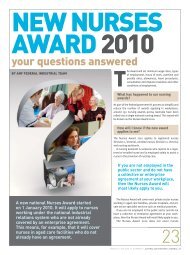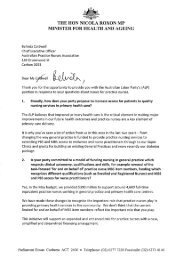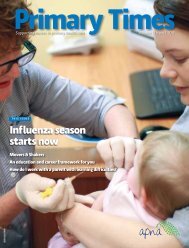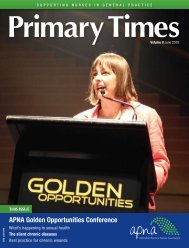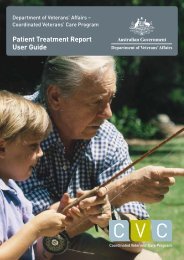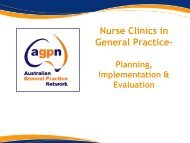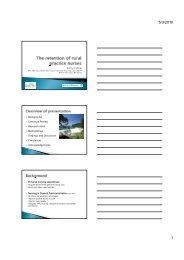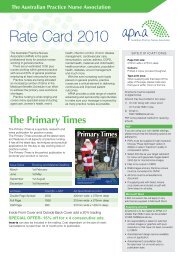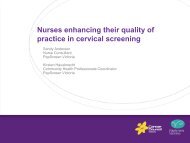Increasing Aboriginal and Torres Strait Islander women's ... - APNA
Increasing Aboriginal and Torres Strait Islander women's ... - APNA
Increasing Aboriginal and Torres Strait Islander women's ... - APNA
- No tags were found...
Create successful ePaper yourself
Turn your PDF publications into a flip-book with our unique Google optimized e-Paper software.
<strong>Increasing</strong> <strong>Aboriginal</strong> <strong>and</strong> <strong>Torres</strong> <strong>Strait</strong> Isl<strong>and</strong>erwomen’s access to BreastScreenS<strong>and</strong>y AndersonBaarlinjan Medical ClinicBallarat & District <strong>Aboriginal</strong> Co-operative Ltd
AcknowledgementI would like to pay my respects to the Wurundjeri people, of the Kulinnation, on whose l<strong>and</strong> we meet today <strong>and</strong> to the Wutherong people withwhom I have had the pleasure to work alongside <strong>and</strong> without thepartnership of the Koori women there would not have been anything toreport to you today.I would also like to pay my respects to the Wurundjeri <strong>and</strong> Wutherongelders both past <strong>and</strong> present <strong>and</strong> all other elders here today
Central Highl<strong>and</strong>s <strong>and</strong> Wimmera BreastScreen
Baarlinjan Medical ClinicBallarat <strong>and</strong> District <strong>Aboriginal</strong> Cooperative
Initiatives for increasing BreastScreen access for Indigenouswomen using a practice wide systematic approachThrough this paper I will highlight the initiatives undertaken to:• Identify where services fail to meet to increasewomen’s access to screening• Developing a systems approach to identify Kooriwomen’s BreastScreen history <strong>and</strong> implement a recall systemto build screening participation• Partnership where both services are committed to increasingKoori women’s access to BreastScreen services.
Victoria showing health Department of Human Servicesregions <strong>and</strong> Primary Care PartnershipsNorthern MalleeLoddon MalleeSouthern MalleeRegional Victoriaincluding Primary Care Partnerships <strong>and</strong>Department of Human Services regional boundariesWimmeraBendigo-LoddonUpper HumeGrampiansCampaspe Goulburn ValleyHumeCentral HumeCentral Victorian Health AllianceEast Gippsl<strong>and</strong>Southern Grampians-GlenelgGrampians PyreneesCentral Highl<strong>and</strong>sMetropolitan mapLower HumeWellingtonGippsl<strong>and</strong>South WestBarwon South WesternCentral West Gippsl<strong>and</strong>Barwon0 50Kilometres100South Coast Health Service ConsortiumBoundaries based on Local Government AreasAustralian St<strong>and</strong>ard Geographical Classification 1 July 2006
BADAC’s role to increase Koori women’s accessto BreastScreenHistory that began the collaboration• From 2006-10 Baarlinjan Medical Clinic staff had workedcollaboratively with Women’s Health Grampians to organise busgroups for Koori women to attend BreastScreen• Women’s awareness of the need for breast awareness <strong>and</strong>BreastScreen were raised at women’s health days, educationsessions <strong>and</strong> individual consultation with women• With much work by all partners there would have been one bustrip a year taking 8-10 women
Past BreastScreen systems for booking women fortheir BreastScreen• Prior to early 2011, all booking for BreastScreen was through acentralised state wide booking number booking about a month ahead• A group booking needed to work on similar timelines butBaarlinjan Clinic bus trips women always changed rightup until the morning of the bus trip• Last minute women booked in would tend to be difficult for BreastScreenstaff to process them in time for their mammogram.• This had the potential to look unwelcoming for the Indigenous womenwho where in generally very wary of mainstream services due to pastdiscrimination• Staff unfamiliar with <strong>Aboriginal</strong> cultural issues
Earlier systems used to identify women for BreastScreen• Prior to early 2011, BADAC could only work from lists of <strong>Aboriginal</strong>women aged 40 – 70 years without knowing their breast cancer history• When the clinic didn’t know the details of the women’s past screeninghistory <strong>and</strong> BreastScreen needed time to access this information soanother complexity was added• If BADAC had 16 women planning to come three days before the trip onthe day they might be lucky to have 8 attend• Some of those would be different from the original list of sixteen
Bus trips to BreastScreen are held every two monthsBallarat puts ongood weather fora bus trip toBreastScreen buta good afternoontea, women’sspace, sometalking time <strong>and</strong>lots of laughtereased theexperience for all.As alwaysdebriefing in thebus on the wayback to BADAC
On one bus trip some of the <strong>Aboriginal</strong> women feltdiscriminated against <strong>and</strong> not very welcomedThe issue was taken to the <strong>Aboriginal</strong>Taskforce meeting a regular occurrencebetween Ballarat Health Services, whoauspice Central Highl<strong>and</strong>s <strong>and</strong> WimmeraBreastScreen <strong>and</strong> BADAC.Issue provided the another catalyst to improve they way bothsystems interactedA plan was made for cultural training for BreastScreen staffbefore the next BADAC women’s bus trip attending BSV
Cultural Training for the Central Highl<strong>and</strong> <strong>and</strong>Wimmera BreastScreen staffKym Kyatt, Women’sHealth & BreastScreenManager said the culturaltraining was excellent –“some staff reported thatthey think it has given staffa different perspective toconsider”.Following the cultural training BADAC women reported the difference<strong>and</strong> felt genuinely welcomed by all staff. Women found themammogram demonstration helpful <strong>and</strong> allayed many of theirconcerns. When the Elder Violet encourage them to tell other womenof their positive experiences they where happy to do so.
Other changes at BreastScreen to increase access• Ability to process women as drop in clients at the Ballarat office or lastminute women joining the BADAC bus trip• Demonstrations of how the machine works, how the radiographerpositions women <strong>and</strong> pressure used to take the mammogram• Had two radiographers working to ensure the bus trip moved throughquickly• Underst<strong>and</strong>ing of the role of additional support staff such as an<strong>Aboriginal</strong> Health Worker or Elder
A group of women returning from BreastScreenHaving asupportingElder VioletMcPhersontravel with upon the bus trips<strong>and</strong> advocateto thecommunity theimportance ofwomen health<strong>and</strong>BreastScreenhas had apowerful impact
Developing new systems at BADAC• Recall system was set up differentiating between women who had adiagnostic mammogram <strong>and</strong> BreastScreen screening – accommodatingover 40 years of age for <strong>Aboriginal</strong> women <strong>and</strong> over 50 years of age fornon <strong>Aboriginal</strong> women• Permission were gathered from women when they accessed the clinic topopulate both Pap test <strong>and</strong> BSV history ie at health checks, bloodcollection, immunizations etc• Women who had a previous BSV history date recorded in progress notes<strong>and</strong> recall established• Women who had a previous diagnostic mammogram with a normal resulthad a recall for BreastScreen added if age appropriate
BreastScreen made further changes to enhance systems• BreastScreen reserved appointment block of time for 10 women• Appointment block made immediately after staff lunch break sowomen had the waiting room beside the change room, for theirspace only• To enhance the women’s outing aspect of the bus trip an afternoontea <strong>and</strong> fresh fruit where provided• BreastScreen introduced to all BADAC staff <strong>and</strong> the elder whowere attending to support the women
BADAC <strong>and</strong> Goolum Goolum ATSI Women’s Health DayA time to gather in the peaceful <strong>and</strong> spiritual spaces at Branbukin Halls Gap, Victoria
Reconnecting with family <strong>and</strong> friends <strong>and</strong> making newfriends <strong>and</strong> breast healthWomen yarning in the beauty of thebush in Halls Gap which is situatedin the Grampians GariwerdNational Park in Western VictoriaEven Esmeralda was seenat Brambuk over a discussionabout Breast Health awareness<strong>and</strong> BreastScreen
ATSI womenIn early April there were 89 ATSI women attending the service aged40-70 yearsTotal number of ATSI women 40-70 years <strong>and</strong> non ATSI women 50-70years with a mammogram recall for any time is 90 totalOver the next 3 months 49 ATSI women are due for their mammogram manyof who will never have had one before
PrimaryCare Sidebar <strong>and</strong> PCS Clinical Audit ToolDue to the service participating in a PrimaryCare Sidebar pilotwhich enables recording mammogram history. The service iscommittee to be entered BreastScreen results manuallyHaving entered it into PrimaryCare Sidebar PCS Clinical AuditTool can provide specific lists of women at various stages of thescreening journey <strong>and</strong> the pop up prompts are greatFrom PCS Clinical Audit Tool lists of recall where then able to beaccessed <strong>and</strong> then specific invitations could be made to KooriwomenPermission to access Pap <strong>and</strong> BreastScreen histories have beenadded into health assessments
Partnership between BADAC <strong>and</strong> BreastScreen continues to growBADAC <strong>and</strong> BreastScreen processesThe program supports women who are not comfortable to make anappointment to attend BreastScreen independently.Comfortable experiences with a mainstream service are always a positivefor future accessWhen talking with women who are not free to attend the planned trip forthe next bus many women want to go on the next trip so the program isgetting momentum.Whilst 49 women are due in 6 months there are already 15 indicatinginterest in the next trip.
BreastScreen <strong>and</strong> BADAC processesAs the Baarlinjan Medical Clinic has been given permission to receiveeach woman’s results.A coordinated approach occurs when a women is called back forassessment. The clinic is notified before the woman <strong>and</strong> an appropriatelydesignated staff member contacts the women after notification to ensuresupport is available <strong>and</strong> also follow up for whatever the processes maybe.I <strong>and</strong> the BreastScreen nurse counsellors connect women with McGrathnurses <strong>and</strong> the Koori Liaison Officer at the hospital.With the clients permission good communication occurs between us all
Closing the Gap - always more to doAll of this work is just the start in ensuring all ATSI women are wellscreenedAnd achieve the benefits which Cuzick recently report that toimprove breast cancer mortality outcomes women need to be wellscreened for five yearsJ.Cuzick 2012 ”Breast cancer screening – time to move forward” , The Lancet, Vol379,Issue 9823, A7 April 2012From the statistics I have quoted from the Baarlinjan MedicalClinic there remains much to be done but a start has been madeWith every interaction Central Highl<strong>and</strong>s <strong>and</strong> WimmeraBreastScreen, Baarlinjan Medical Clinic <strong>and</strong> the ATSI women ofthe local community are working together to improve womenaccess to screening <strong>and</strong> better health outcomes
S<strong>and</strong>y AndersonWomen’s Health NurseBaarlinjan Medical ClinicBallarat <strong>and</strong> District <strong>Aboriginal</strong> CooperativePhone: (03) 5331 5344Email: s<strong>and</strong>erson@badac.net.au



